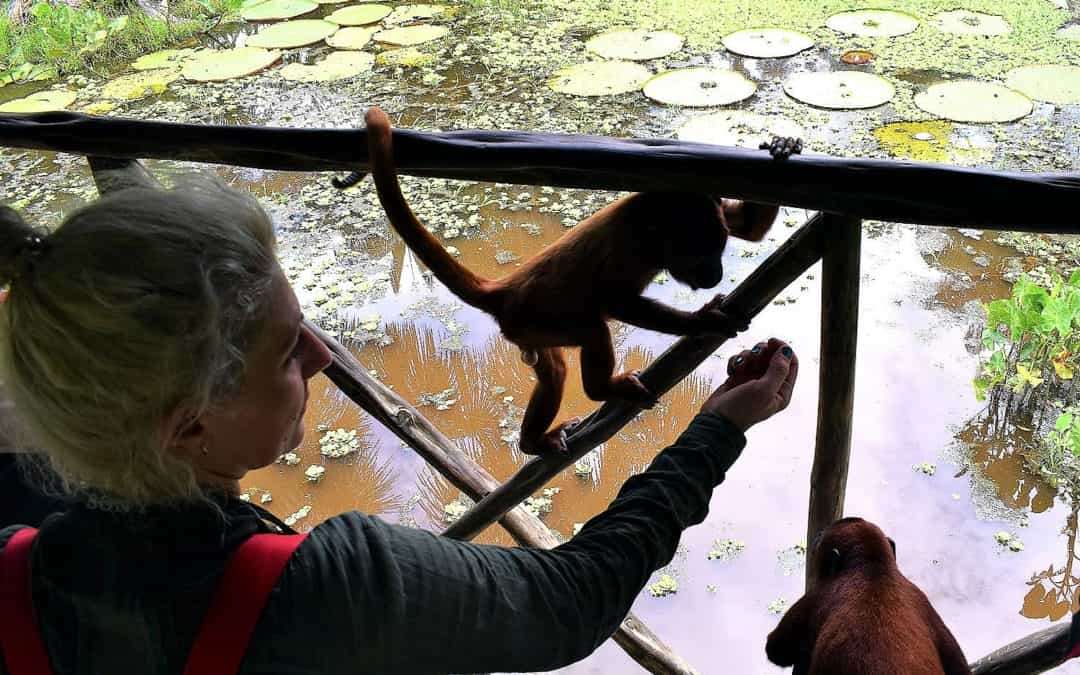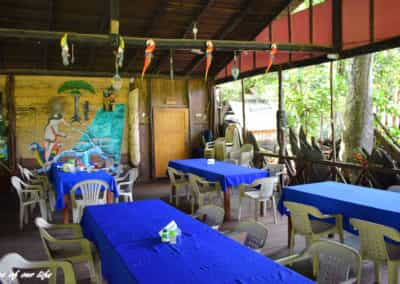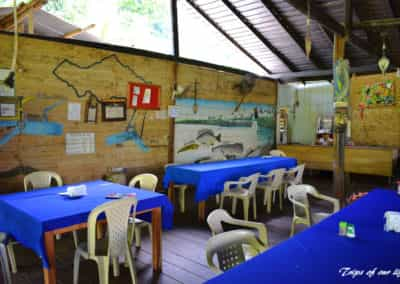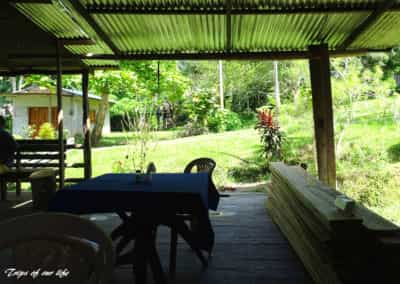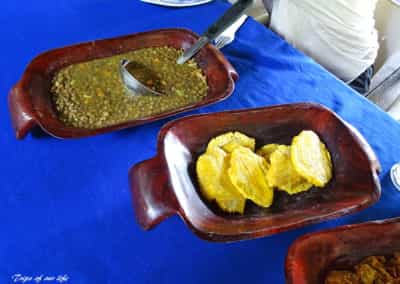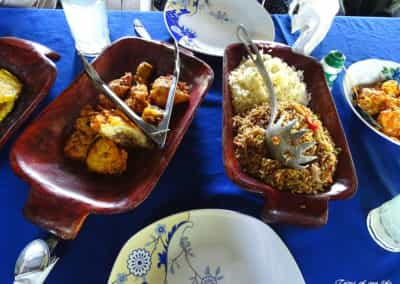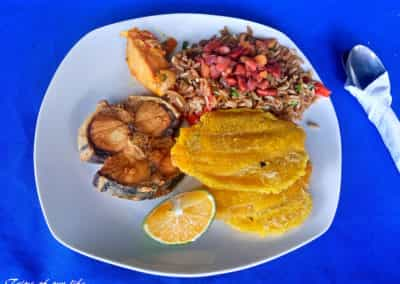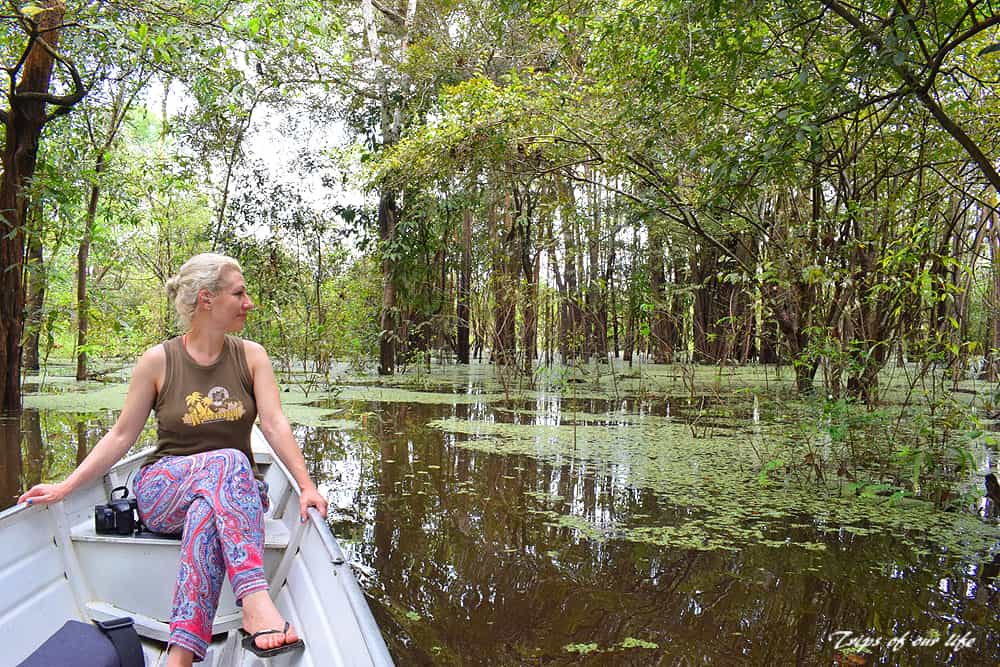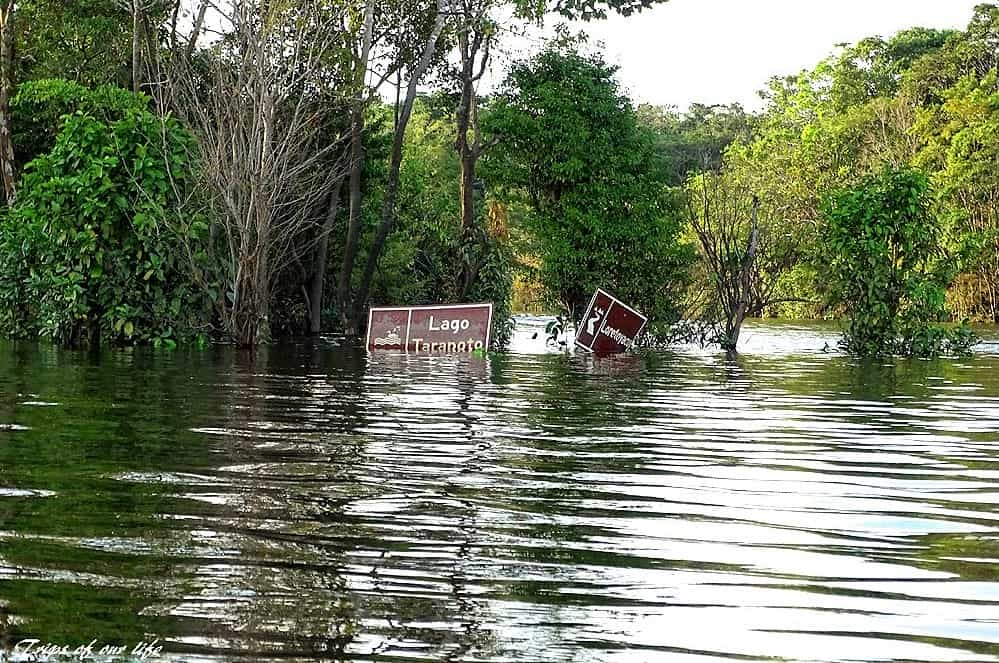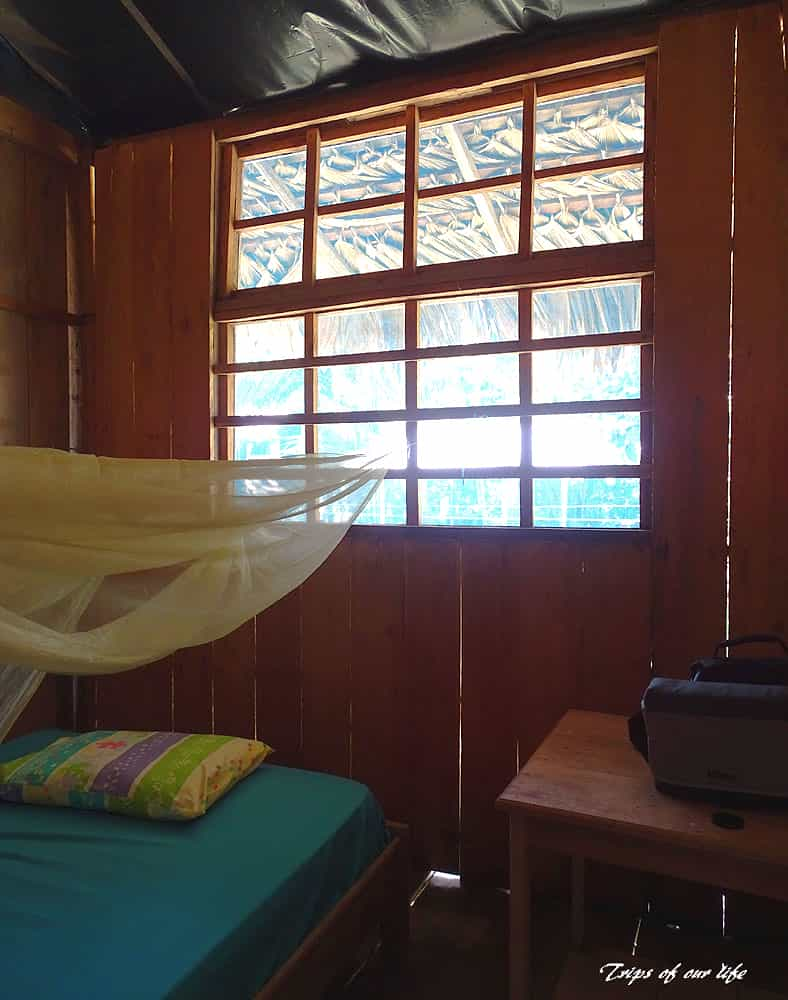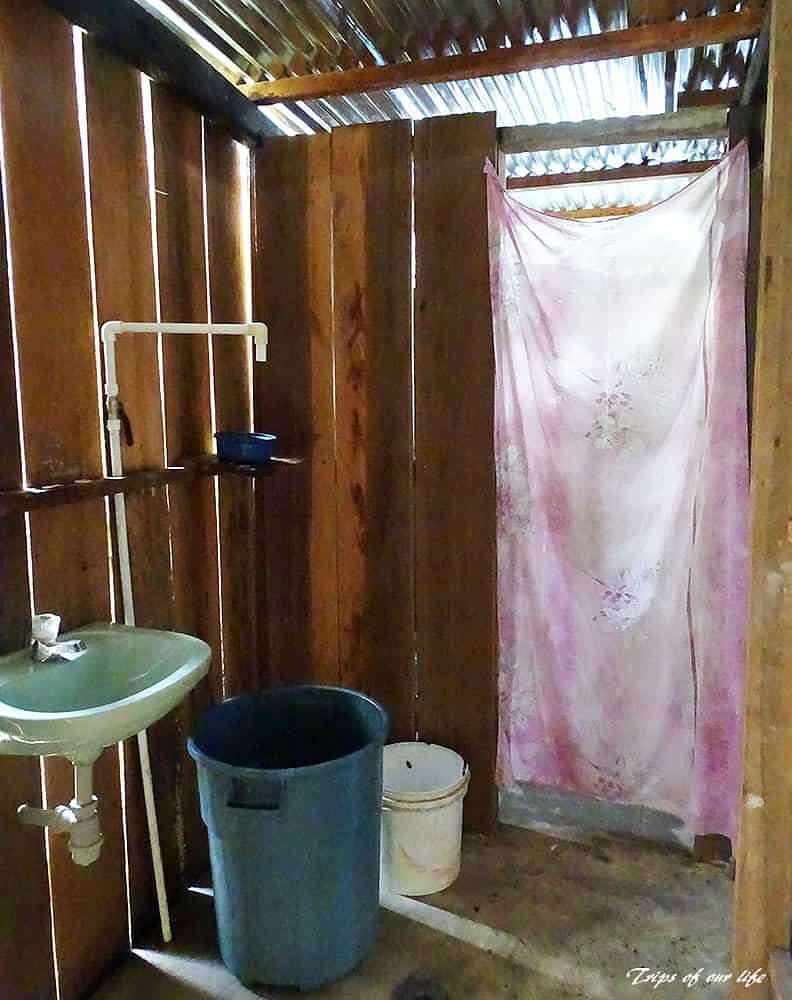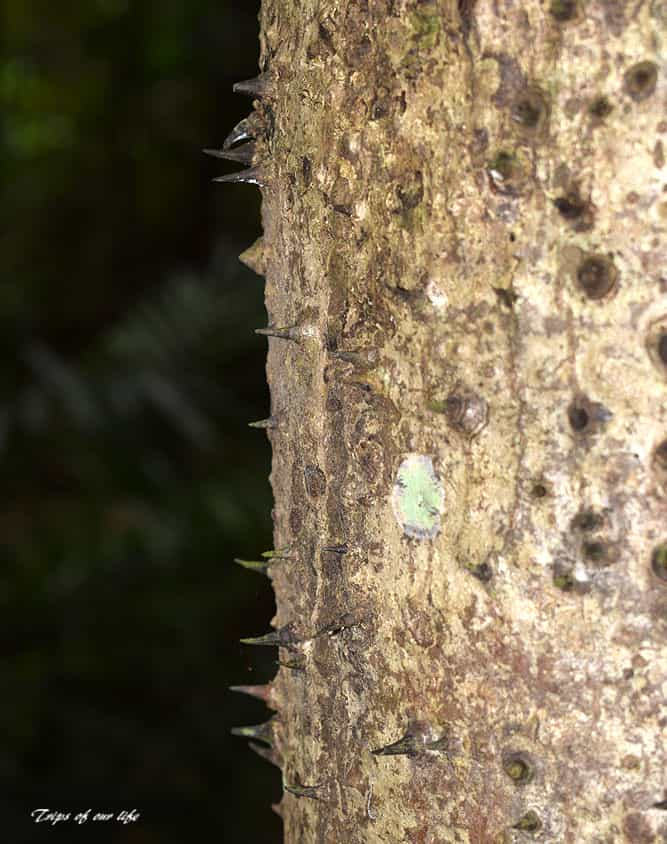The local restaurant
Our accommodation included breakfast, lunch and dinner in a small wooden restaurant located on the way to the port. The area generally is not famous for the great food variety, but everything we tried was delicious! The breakfast was simple, choosing between 2-3 kinds of omelet, fresh fruits and fresh lemon juice. The rest of the meals consisted of farina (made of yuca flour) or lentil soup, fried chicken or fish (the latter was mainly pirarucu) together with rice or noodles and always accompanied with fried banana (called platanos, which is a sort of big banana that is only used in cooking, as it cannot be eaten raw). Fish was super fresh, since they were fishing them early in the morning and bringing them to the restaurant during our breakfast!
Organizing a trip to the Amazonian rainforest seems scary at first, but, to be honest, everything was easier than I originally thought. Appropriate clothing and necessary accessories are the crucial factor to enjoy your trip and to avoid unexpected health issues. No, don’t be afraid, nothing can go wrong, provided that you are careful with the ambient environment and that you always follow your guide’s instructions and take precautions.
First of all, you don’t need to carry much, besides a backpack with the absolutely basic clothes & shoes, as wandering around mostly has to be made by boat. The trip is quite rough and you won’t have the opportunity to change clothes often, neither freshen up nor renew your makeup.
So, let’s take a look at the stuff we had to arrange, as to enjoy our 5 days in the Amazon without facing the least problem:
–Nutrition: as in most trips outside Europe, we were drinking only bottled water. The travel agency had supplied us with huge bottles of water since the very beginning of the trip, and we were always carrying our own bottles, as it is necessary to drink a lot of water to avoid dehydration because of high humidity and temperature. We didn’t have to carry food, as, firstly, at some point we were returning to our village for lunch anyway, and, secondly, as in the jungle we were always able to eat fresh fruit. Eating everywhere was always safe.
–Vaccines: before each trip, a visit to our family doctor is necessary, so that we can get recommendation on what we need to be vaccinated against. For the rainforest, the vaccines against hepatitis and yellow fever are necessary.
–Clothing: the clothes (and underwear) were mainly of cotton, or generally of light and breathable material that do not make the body sweat, as nylon does (mostly long sleeved shirts and long pants). Tropical climate is very humid and hot, so the clothes have to be suitable for these conditions. You will sweat even immediately after having a shower, so, imagine how much more during a walking tour inside the jungle. Concerning shoes, we only had a pair of trekking shoes and flip flops to wear in the room. During the walking in the rainforest, we were wearing rainboots, which the travel agency had supplied us for the mud. Sunscreen, sunglasses and hat are a must, as the place is close to the Equator and sun is much harsher.
–Mosquitos and tropical diseases: the usual problem of the tropics! Malaria and yellow fever are the most dangerous diseases in tropical countries deriving from mosquito stings. For malaria, you may find pills in the pharmacy and for the yellow fever there is a vaccine. Where we visited, they informed us that there is no malaria issue, at least during that specific period, so we did not use at all the pills (I carry them in such countries anyway). The yellow fever vaccine is supposed to be obligatory and, as a matter of fact, they supply it on site in Bogota, to whoever is going to travel to Amazonia, if they have not had it already. We were already vaccinated and had the relevant stamp on the travel health card (the yellow book), which, however, nobody checked neither in the Bogota airport, nor while entering Amazonia. The most effective protection against mosquitoes is actually the appropriate clothing and mosquito repellent. Our everyday clothes were long-sleeved shirts and long trousers worn inside the rainboots, so as to expose as little skin as possible. Whoever does not have any serious problem with mosquitoes, this protection is adequate. However, as I am particularly sensitive to mosquito stings, I had to be extra cautious: I was continuously using a mosquito repellent specialized and strong enough for the tropics and sprayed it on skin and on the clothes. During night, I was using a natural, lighter mosquito repellent of eucalyptus essential oils on the body and mosquito repellent cream on hands and face and the mosquito net of the bed. Especially during our trips in the jungle, you need anyway a strong repellent consisting of DEET. Particularly for our stay in the Tarapoto lake, we used repellent with DEET 50%. The rest of the days, simple mosquito repellent was enough, even while wearing t-shirts.
**Pay attention at the airport! During the route from/to Leticia it is forbidden to carry mosquito repellent in carry-on luggage, regardless of the size of the bottle. As mentioned above, we traveled to the Amazonia only with our backpacks and the absolutely necessary, since we left most of our clothes in the Bogota hotel. Well, flying towards Leticia we had a free luggage included in the airfare price with Avianca, so we checked in our backpacks as normal luggage and we didn’t even notice that such an issue with mosquito repellents may arise. During our return with Latam, though, our ticket didn’t include a luggage, so we had to carry our backpacks as ordinary carry-on luggage. Therefore, during the control they did not allow us to keep our mosquito repellents, even though each bottle was less than 100ml. After my request, because some of them were expensive, the security employees suggested that I should ask the airline to send them to Bogotá as a package. Fortunately, they accepted without charging us, so I received them directly in the capital airport.
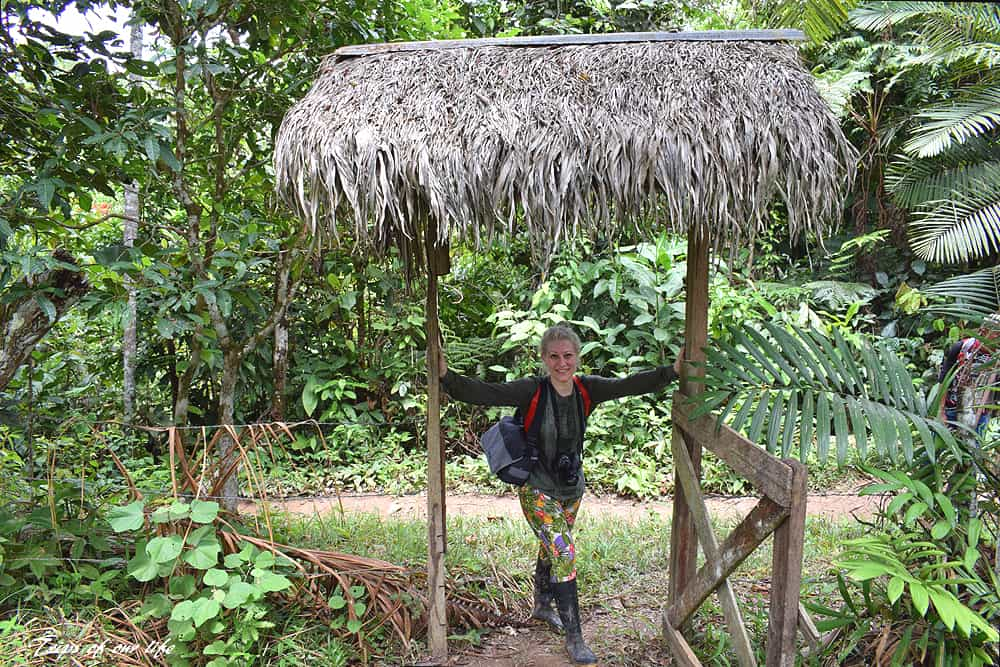
The everyday jungle outfit: long sleeves, long pants, rainboots and a strong insect repellent
–Personal hygiene: generally, there is running water for showering but only at room temperature. We had antibacterial liquid and wipes with us at all times, as well as baby wipes, a small face towel and a bigger one. In Leticia and Puerto Nariño we had a private toilet and shower in the room, but in Tarapoto lake, the toilet was shared and there was no running water. So, after a whole day in the jungle and with tons of strong mosquito repellent and sweat on us, even though we certainly needed a nice shower, we had to be patient until the following day when we would be back to Puerto Nariño. I swam in the lake with dolphins and I had some water poured on me with a bucket before sleeping, so it was actually not a big deal for just one night. Put aside also that we would have to wear the same dirty clothes the next day anyway…
-The personal pharmacy is necessary but fortunately we did not need it! I always carry my own medications, pills for diarrhea (I recommend Imodium express for faster action), for vomiting, antihistamines for any allergies and creams like Fenistil or ammonia for mosquito stings. However, I am convinced that no matter what might have happened, the locals would have provided the necessary medicine. Anyway, during our excursion in the jungle, our guide was showing us various natural products from the bark of trees or other plants that locals use as bug repellent oil, as sunscreen and as drinks for several diseases.
–Extra travel insurance is not needed, but it would be good to get informed from your insurance company for your own safety, before you start your journey.
The travel agency that organizes the trip provides raincoats for the storms and rainboots for the mud and for bites and stings. The period that we visited the Amazon was in between the dry and the rainy season, this is why Tarapoto lake was flooded from the waters of the Amazon and the jungle was full of mud and hidden reptiles. The local guides know the jungle better than anyone and can respond to any challenge in the best way. Hence, it is very important to follow their instructions, even if some may seem irrational, like the way we have to walk in the mud during night to avoid unpleasant confrontations with snakes, as well as what to touch and what not, as even a seemingly innocent tree trunk could cause a serious health issue.
Boat ride around the flooded forests of Puerto Nariño
Τhe flooded lake Tarapoto; the water level was still rising
The trip to the Colombian Amazon has lots of pros but also cons.
As the area is cut off from the rest of the country, tourism is not really developed. Touristic infrastructure and services are of average quality level and the part of the Amazon where a visitor can explore is small in Colombia, compared to that of the neighboring countries. Primitive and distant tribes obviously do not exist, as all have been westernized to a large or smaller extent. Also, we did not meet any wild animals, maybe it was not the appropriate season or area, who knows. The only animals we met, free in nature of course, were monkeys, sloths, various bird species, caimans and the grey and pink Amazonian dolphins. I am not sure how easy or difficult is to confront other animals as well in such a huge area of dense jungle, however, I hoped to meet more of them whatsoever.
On the other hand, lack of tourism has also a positive side. Fewer visitors means that you can be alone in the whole area! As mass tourism has not reached yet this part of the region, we did not meet any tourists at all in the jungle, not even during a single day. On the small Peruvian island, we were the only visitors and in Tarapoto lake it was only us and 2 other tourists!
The locals are still innocent, they don’t care for their profit alone and to earn money from tourists. They do not expect tips, they are polite but not servile, and are keen on assisting without waiting something in return. Generally, it stroke us their behavior not only toward us but also to all animals. They do not keep any jungle animals imprisoned and they do not exploit dolphins to earn money. It is not allowed to feed them, in contrast to other countries, in order to approach them and get photos for the tourists. They also do not try to fetch sloths or monkeys so as to please the customers and get a tip, and generally they respect nature.
Puerto Nariño is considered a model village, the residents clean it themselves and give fees to whoever litters. Regarding nature, the rainforest in the Colombian side is absolutely amazing! The vegetation is lush and with a large diversity of flowers, seeds and fruit! The country is famous anyway for the great variety of fruit, some of which are unique worldwide. It was unbelievable how many different fruit we tasted during our tour in the jungle part just behind P.Nariño!
Regarding the 4-day tour I booked via Amazonas jungle tours, I personally consider it too expensive in relation to the overall prices in the country, which are generally very low. Also, accommodation quality was not very good. Our rooms during the 2 nights in P.Nariño were old, the bathroom doors had problems in both cases and there were insulation issues: the rain water pouring inside the room along the walls and our clothes being scattered across the room and our photographic equipment being endangered. On the other hand, though, the tour was private, included everything (full board and water, transportation, guide during all the tours for all days), resulting in spending no more money than just buying some souvenirs.
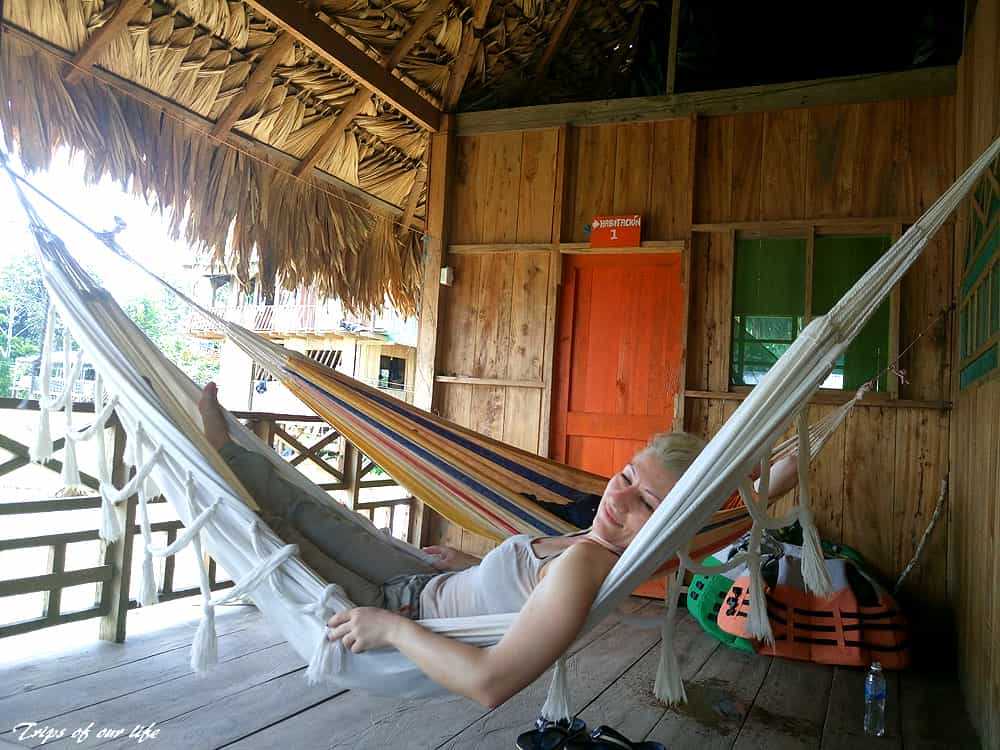
Chilling on the balcony of our wooden house at Tarapoto lake
Finishing this large post, I would also like to express a couple of personal thoughts.
When organizing such a trip, unfortunately you cannot possibly be aware of some things beforehand: not all these practical details that now you may be able to find on the internet, but mainly personal information that actually refer to your own limits. I always dreamt of visiting the region of the Amazon, even though I maintained a level of phobias: dirt, lack of comforts, diseases, and above all bugs (I have a huge phobia for bugs)! When I actually decided to organize a trip to the Amazon together with the rest of Colombia, I was afraid that several problems would arise. For this reason, I considered 5 days to be totally adequate so as not to confront any really difficult situations.
In the end, the problem was that not only I did not face any difficulty regarding my phobias, but it was proven that this destination became one of my top ones of my whole life!
The Amazon for sure is not for everyone!
I do not know how the respective trip to the neighboring countries could be, but in the Colombian Amazon there is no luxury, no internet, no comforts and no gourmet cuisine.
You are placed in the middle of nowhere, inside a jungle with myriads of mosquitos, free wild animals, endless bugs of big sizes and very dense vegetation. You have to walk in the mud, sleep with cockroaches, spray yourself continuously with mosquito repellents, be constantly sweaty and maybe not have the luxury of everyday showering.
Whoever cannot even imagine the idea of all the above, should better let it go.
Whoever is not sure, please do try the experience. And if someone makes the same mistake like me, to book only for 5 days and then regret it, well, that’s life, there is also the Amazon in the neighboring countries!
Our room at Tarapoto lake; the mosquito net is necessary for the protection while sleeping
Our bathroom; the “bucket shower” and the toilet behind the curtain
Nothing is innocent in the jungle, not even the trees

